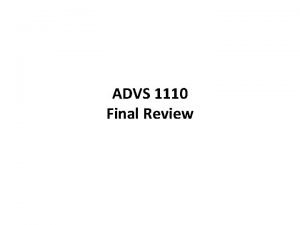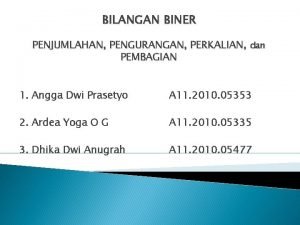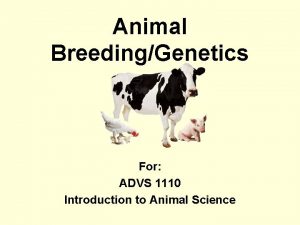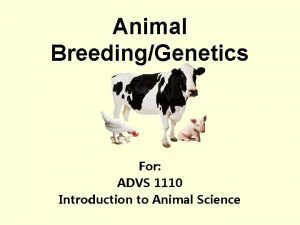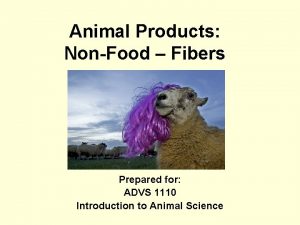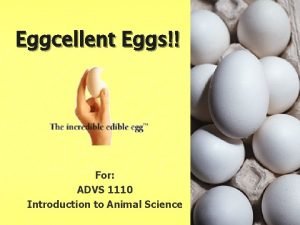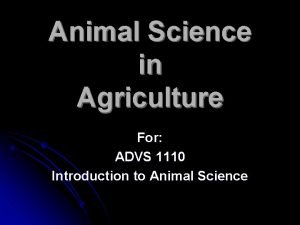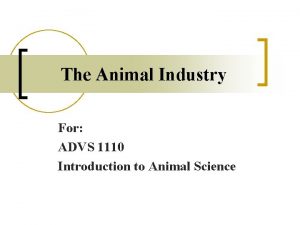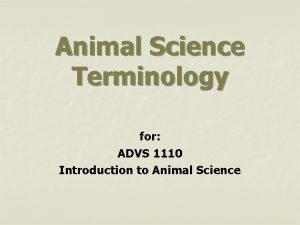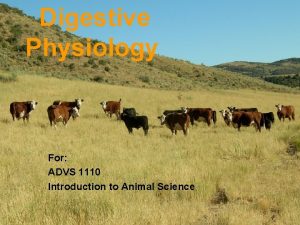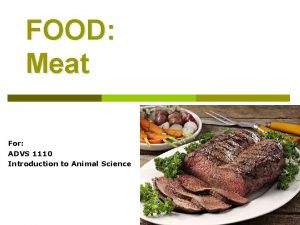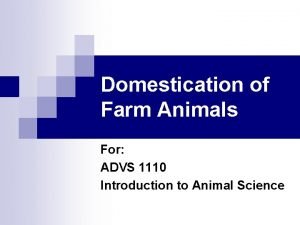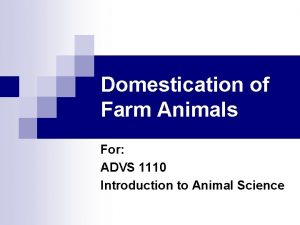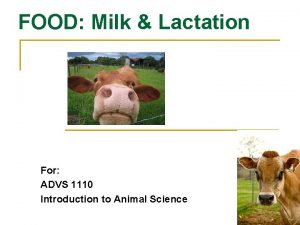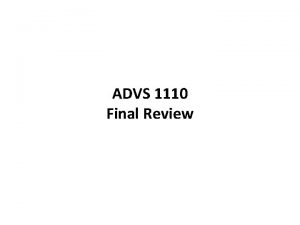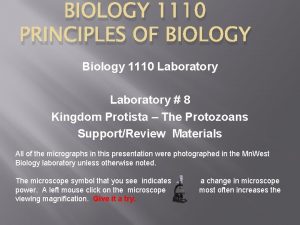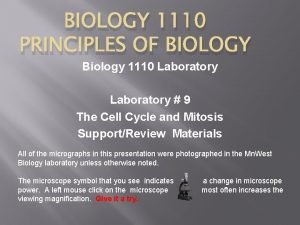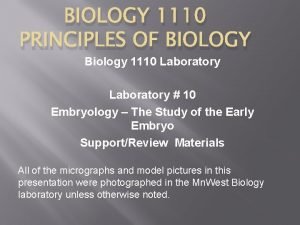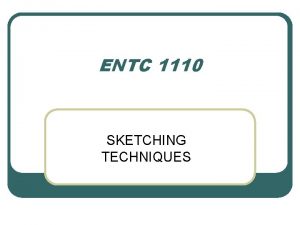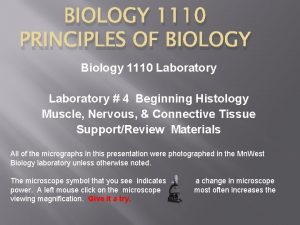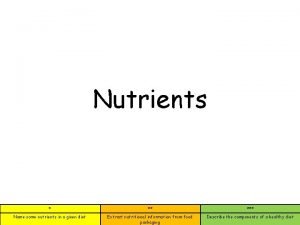Nutrients Prepared for ADVS 1110 Introduction to Animal

































- Slides: 33

Nutrients Prepared for: ADVS 1110, Introduction to Animal Science

What is Nutrition! Nutrition is the science of food/feed utilization by body processes which transform food/feed into body tissues and energy.

ANIMAL NUTRITION n n n Feed usually represents the single biggest expense in animal production. It generally accounts for >50% of the total cost of production. Labor is generally second at about 10%.

To efficiently obtain and utilize available feed stuffs for animal maintenance and production of meat, milk, eggs, fiber and work.

What is a Nutrient? A constituent of food/feed that functions in the support of life, growth, and production.

Digestible Nutrient The portion of the nutrient which may be broken down (digested) and absorbed and used by the body.

The Six Nutrients • Protein • Carbohydrates • Fats • Minerals • Vitamins • Water

Animal Nutrition n Measures of Energy and Energy Utilization:

Proteins v Needed for growth and repair v Helps form muscles, internal organs, skin, hair, wool, feathers, hoofs and horns v Contain carbon, hydrogen, oxygen and nitrogen v Not a good source of energy

Feeds rich in Protein 1. 2. 3. 4. 5. 6. Meat and Blood Meal Fish Meal Soybean Meal Cottonseed Meal Dried Skim Milk Amino Acids

Carbohydrates • Furnish energy for body functions, growth and reproduction • The largest part of the animals food supply and usually the fibrous part of the diet • Include sugars, starch and cellulose • Are made of carbon, oxygen and hydrogen

Fats/Oils • Furnish a concentrated source of energy, up to 2. 25 times as much energy as carbohydrates • Form cholesterol, steroids and other body compounds • Affect the condition of skin and hair • Are made of carbon, oxygen and hydrogen, but contain much larger proportions of carbon and hydrogen than carbohydrates • They also provide energy reserves, protection for vital organs, and they insulate the body -AKA- Lipids

Minerals Ø Primarily found in bones and teeth Ø Important in blood for the carrying of oxygen Ø Regulates heartbeat with potassium, sodium and calcium - Macro/Micro Example: Calcium Formation Found in rocks

Minerals Ø Minerals required in relatively large quantities are referred to as Macrominerals (Ca, P, Na, Cl, Mg, K) Ø- Micro or Trace mineral are required in relatively small amounts (Mn, Co, Cu, Fe, I, Zn, S, Mo)

VITAMINS • Are only needed in small amounts • Are essential for life and health • Provide a defense against disease, promote growth and reproduction • Contribute to the general health of the animal -Fat Soluble/Water Soluble

WATER • Accounts for 70% or more of the body composition of most plants and animals

FEED CLASSIFICATIONS Most feeds have some of each of the nutrients in them. FORAGES/ROUGHAGES-contain more structural carbs (Cellulose, Hemicellulose, Lignin) CONCENTRATES-contain more nonstructural carbs (sugars, starch), protein, and fat.

ROUGHAGES/Forages • High in Fiber and relatively low in digestible nutrients. Whole plant. Examples: 1. Alfalfa hay/haylage 2. Clover 3. Grass 4. Oat hay 5. Corn Silage

Concentrates • Are low in fiber and high in digestible nutrients. Usually seeds Examples: 1. Corn 2. Cottonseed 3. Barley 4. Oats 5. Soybeans

Supplements • Supplements typically refer to Vitamins, Minerals, Anti-biotics, Probiotics • Added in relatively small amounts • Don’t contain the variety of nutrients that other feedstuffs have • Expensive Salt Copper

Nutrient Access and availability n Feed Processing increases feed particle surface area or physically alters it so that microbes, enzymes, acids, etc. in the GI tract can “mine” the nutrients. n Some processes change the chemical structure (steam flaking, roasting) and/or increase palatability. n Roast, steam, temper, flake, grind, pulverize, roll, extrude, pellet, chop, dehydrate, sprout, culture……

Animal Nutrition n Chemical Analysis Scheme of Organic and Inorganic Nutrients: (K & Mg should be macro)

Animal Nutrition n Chemical Analysis of Feedstuffs – The “Proximate Analysis”:

Animal Nutrition

Animal Nutrition n The amino acids most commonly found in proteins: Alanine Glycine Proline Arginine* Histidine* Serine Asparagine Isoleucine* Threonine* Aspartic Acid Leucine* Tryptophan* Cysteine Lysine* Tyrosine Glutamic Acid Methionine* Valine* Glutamine Phenylalanine* * - Essential amino acids in animal diets.

Animal Nutrition n Don’t forget the ‘essential amino acids’ in animal diets = q “PVT. TIM HALL”

Animal Nutrition n Some of the stages in the carbon cycle:

Animal Nutrition n Some of the main stages in the nitrogen cycle:

Animal Nutrition National Research Council (NRC) Classification of Feedstuffs Feed Class Typical Feedstuffs and/or Products Dry Forage or Roughage Hays Straws Seed Hulls Fodder (aerial parts w/ears, husks or heads) Stover (aerial parts w/o ears, husks, or heads) Succulent Forage or Roughage Pasturage Range Plants Soiling Crops

Animal Nutrition National Research Council (NRC) Classification of Feedstuffs (continued) Feed Class Typical Feedstuffs and/or Products Silages Grain Crop Silage Grass Silage Haylage Energy Grain and Seeds Mill by-products Fruits Nuts Roots

Animal Nutrition National Research Council (NRC) Classification of Feedstuffs (continued) Feed Class Typical Feedstuffs and/or Products Protein Supplements Animal by-products Marine by-products Avian by-products Plant by-products Mineral Supplements Natural or Pure Vitamin Supplements Natural or Pure

Animal Nutrition National Research Council (NRC) Classification of Feedstuffs (continued) Feed Class Typical Feedstuffs and/or Products Additives Antibiotics Coloring materials Flavors Hormones Medicants Source: National Academy of Sciences – National Research Council

The End…. . Questions….
 Advs
Advs Er 1110-2-1156
Er 1110-2-1156 Pengurangan biner
Pengurangan biner Uva calculus placement test
Uva calculus placement test 126 (desimal) = … (biner)
126 (desimal) = … (biner) 7a16 bằng bao nhiêu hệ thập phân
7a16 bằng bao nhiêu hệ thập phân Upsorn praphamontripong
Upsorn praphamontripong Itu-t p.1100
Itu-t p.1100 How animal cells use nutrients
How animal cells use nutrients Vitamins and diseases
Vitamins and diseases Fspos vägledning för kontinuitetshantering
Fspos vägledning för kontinuitetshantering Novell typiska drag
Novell typiska drag Tack för att ni lyssnade bild
Tack för att ni lyssnade bild Returpilarna
Returpilarna Varför kallas perioden 1918-1939 för mellankrigstiden?
Varför kallas perioden 1918-1939 för mellankrigstiden? En lathund för arbete med kontinuitetshantering
En lathund för arbete med kontinuitetshantering Kassaregister ideell förening
Kassaregister ideell förening Tidböcker
Tidböcker Sura för anatom
Sura för anatom Förklara densitet för barn
Förklara densitet för barn Datorkunskap för nybörjare
Datorkunskap för nybörjare Tack för att ni lyssnade bild
Tack för att ni lyssnade bild Hur skriver man en debattartikel
Hur skriver man en debattartikel För och nackdelar med firo
För och nackdelar med firo Nyckelkompetenser för livslångt lärande
Nyckelkompetenser för livslångt lärande Påbyggnader för flakfordon
Påbyggnader för flakfordon Kraft per area
Kraft per area Svenskt ramverk för digital samverkan
Svenskt ramverk för digital samverkan I gullregnens månad
I gullregnens månad Presentera för publik crossboss
Presentera för publik crossboss Vad är ett minoritetsspråk
Vad är ett minoritetsspråk Kanaans land
Kanaans land Klassificeringsstruktur för kommunala verksamheter
Klassificeringsstruktur för kommunala verksamheter Luftstrupen för medicinare
Luftstrupen för medicinare
